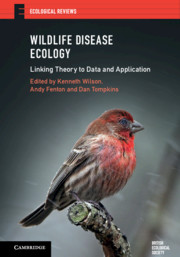Crossref Citations
This Book has been
cited by the following publications. This list is generated based on data provided by Crossref.
Poulin, Robert
Bennett, Jerusha
de Angeli Dutra, Daniela
Doherty, Jean-François
Filion, Antoine
Park, Eunji
and
Ruehle, Brandon
2020.
Evolutionary Signature of Ancient Parasite Pressures, or the Ghost of Parasitism Past.
Frontiers in Ecology and Evolution,
Vol. 8,
Issue. ,
Hulme, Philip E.
Baker, Richard
Freckleton, Robert
Hails, Rosemary S.
Hartley, Matt
Harwood, John
Marion, Glenn
Smith, Graham C.
and
Williamson, Mark
2020.
The Epidemiological Framework for Biological Invasions (EFBI): an interdisciplinary foundation for the assessment of biosecurity threats.
NeoBiota,
Vol. 62,
Issue. ,
p.
161.
Bucci, Melanie E.
2020.
Books and Literature.
The Journal of Wildlife Management,
Vol. 84,
Issue. 4,
p.
832.
Brandell, Ellen E.
Becker, Daniel J.
Sampson, Laura
and
Forbes, Kristian M.
2021.
Demography, education, and research trends in the interdisciplinary field of disease ecology.
Ecology and Evolution,
Vol. 11,
Issue. 24,
p.
17581.
Corripio-Miyar, Yolanda
Hayward, Adam
Lemon, Hannah
Sweeny, Amy R.
Bal, Xavier
Kenyon, Fiona
Pilkington, Jill G.
Pemberton, Josephine M.
Nussey, Daniel H.
and
McNeilly, Tom N.
2022.
Functionally distinct T-helper cell phenotypes predict resistance to different types of parasites in a wild mammal.
Scientific Reports,
Vol. 12,
Issue. 1,
Wigley-Coetsee, Corli
Strydom, Tercia
Govender, Danny
Thompson, David I.
Govender, Navashni
Botha, Judith
Simms, Chenay
Manganyi, Adolf
Kruger, Laurence
Venter, Jacques
Greaver, Cathy
and
Smit, Izak P.
2022.
Reflecting on research produced after more than 60 years of exclosures in the Kruger National Park.
Koedoe,
Vol. 64,
Issue. 1,
Thieltges, David W.
and
Goedknegt, M. Anouk
2023.
Parasites and Biological Invasions.
p.
100.
Bojko, Jamie
Collings, Amber J.
Burgess, Amy L.
and
Goode, Jack A.
2023.
Parasites and Biological Invasions.
p.
8.
García, J. T.
Pérez‐Rodríguez, L.
Calero‐Riestra, M.
Sánchez‐Barbudo, I.
Viñuela, J.
and
Casas, F.
2023.
Sexual differences in blood parasite infections, circulating carotenoids and body condition in free‐living red‐legged partridges.
Journal of Zoology,
Vol. 320,
Issue. 4,
p.
260.





